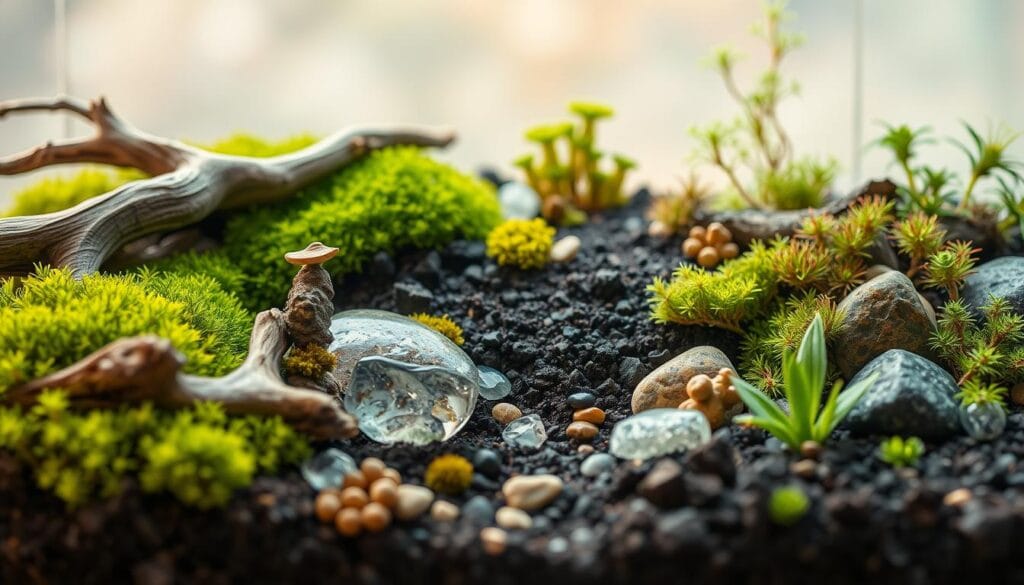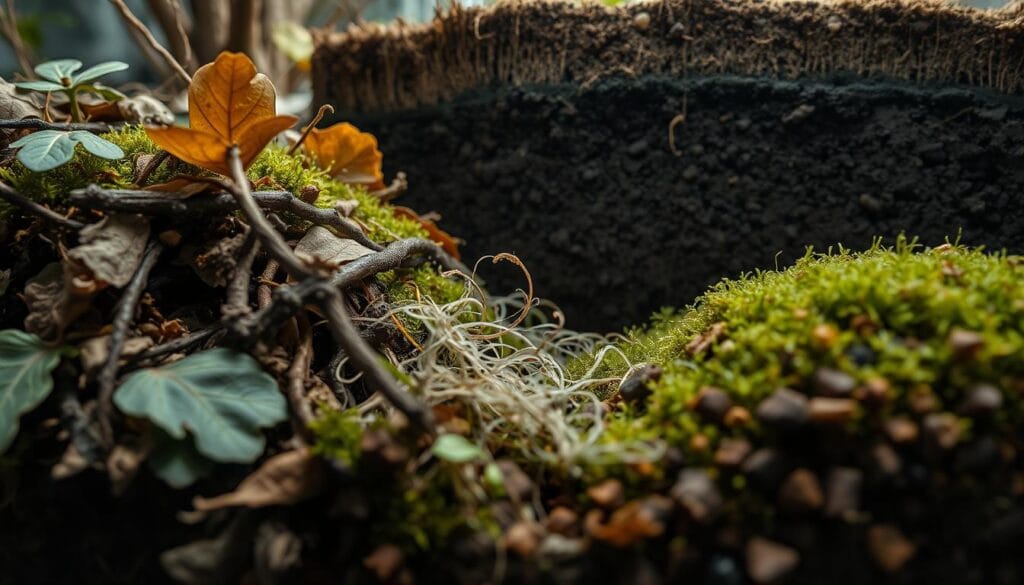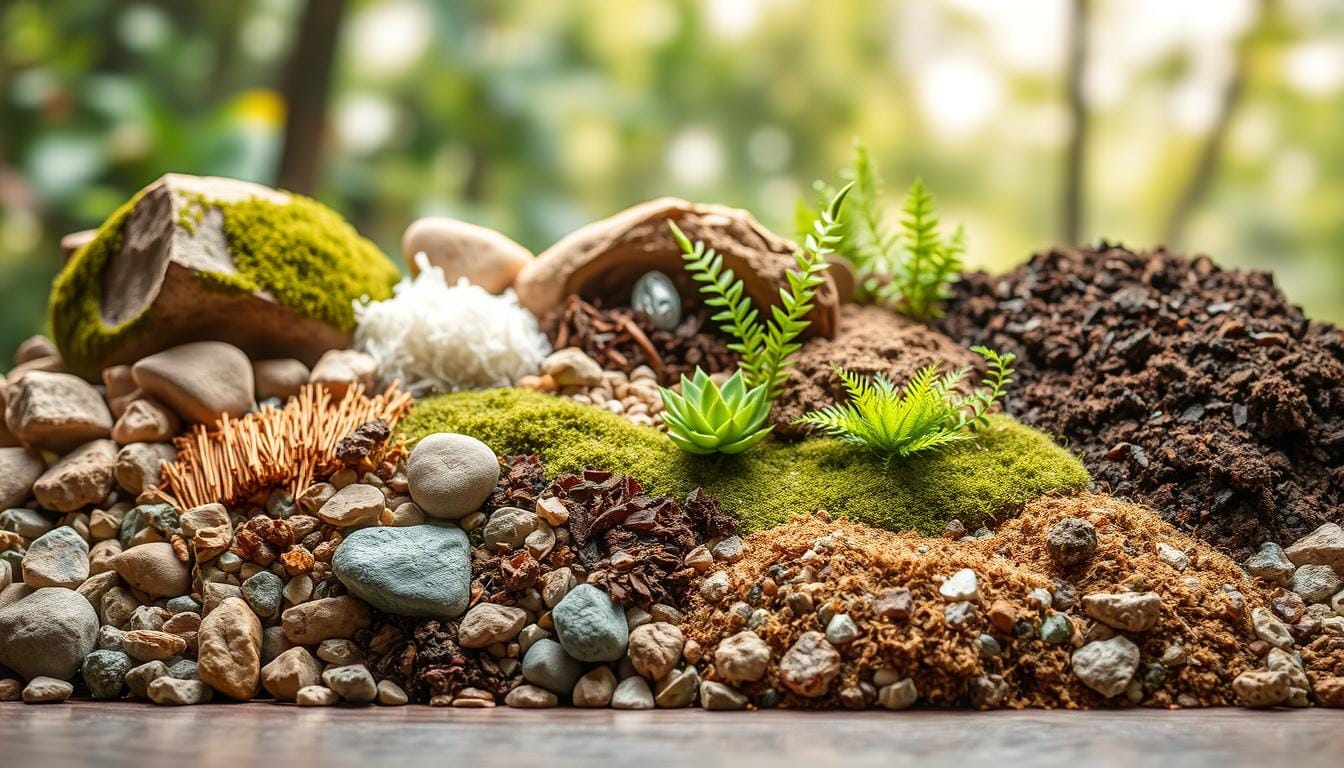Creating a thriving terrarium ecosystem starts with the right substrate. The right one can turn a dull space into a lively, self-sustaining world. By picking a high-quality substrate, you help your plants grow strong and support beneficial microorganisms.
Using trending bioactive substrates for terrariums can take your terrarium to the next level. These substrates are made to mimic nature, creating a balanced and sustainable space. They help plants and microorganisms thrive together.
Table of Contents
Understanding Bioactive Substrates
For terrarium lovers, knowing about bioactive substrates for terrariums is crucial. These substrates aim to replicate natural settings. They help create a balanced ecosystem in your terrarium.
What Are Bioactive Substrates?
Bioactive substrates mix organic and inorganic materials. They support plant growth and microbial life. These substrates are made to be low-maintenance, with beneficial microbes that break down organic matter and recycle nutrients.
Benefits of Bioactive Substrates in Terrariums
Using bioactive substrates in terrariums offers many benefits. Some key advantages include:
- Improved plant health and growth
- Less need for fertilizers and pesticides
- More biodiversity in the terrarium
- Better ecosystem services like nutrient cycling and decomposition
| Characteristics | Traditional Substrates | Bioactive Substrates |
|---|---|---|
| Microbial Activity | Limited | High |
| Organic Matter Breakdown | Slow | Rapid |
| Nutrient Cycling | Minimal | Enhanced |
| Maintenance Requirements | High | Low |
Understanding bioactive substrates helps you create a thriving terrarium. It brings joy and beauty to your space.
Key Components of Bioactive Substrates
To create a healthy terrarium, knowing the key components of popular bioactive terrarium substrates is crucial. A balanced substrate supports plant growth and keeps your terrarium thriving. It’s essential for a successful terrarium.
The main components are organic materials, inorganic materials, and microfauna. Each part is vital for a thriving bioactive ecosystem.
Organic Materials
Organic materials are the heart of a bioactive substrate. They provide nutrients and energy for plants and microorganisms. Some top organic materials include:
- Coconut coir: A sustainable, renewable resource that retains moisture and supports beneficial microorganisms.
- Leaf litter: Decomposed leaves that add nutrients and structure, supporting a diverse range of microfauna.
- Peat moss: An acidic, carbon-rich material that helps retain moisture and lower the pH of the substrate.
Together, these organic materials create a fertile environment. They support plant and microorganism growth.
Inorganic Materials
Inorganic materials are also key. They provide structure, drainage, and aeration. Some common inorganic materials include:
- Sand: Improves drainage and prevents waterlogging, reducing the risk of root rot and other problems.
- Perlite or vermiculite: Enhances aeration and water retention, creating a more balanced substrate.
- Pumice or lava rock: Adds structure and improves drainage, helping to prevent the substrate from becoming too dense.
These inorganic materials help create a balanced substrate. They support healthy root growth and prevent common problems.
Microfauna Integration
Microfauna, like springtails and isopods, are tiny but crucial. They break down organic matter and recycle nutrients. Integrating microfauna into your substrate creates a self-sustaining ecosystem.
“The inclusion of microfauna in bioactive substrates is a game-changer for terrarium enthusiasts. These tiny organisms work tirelessly to break down organic matter, recycle nutrients, and create a healthy, balanced environment.”
To add microfauna, introduce them directly or create a habitat for them. This can involve adding specific species or creating a nutrient-rich environment. This supports their growth.
Popular Bioactive Substrates
Choosing the right bioactive substrate is key for a balanced terrarium. There are many options, making it hard to pick the best one. Let’s look at some top bioactive substrates for terrariums.
Coconut Coir
Coconut coir is a top choice for terrariums. It holds water well and supports good microorganisms. It’s made from coconut husk and is eco-friendly. But, make sure to get high-quality coconut coir without harmful stuff.
For a full terrarium setup, check out kits like the Jumping Spider Terrarium Kit. It comes with coconut coir and is a great start for your terrarium.
Organic Soil Mixes
Organic soil mixes are also popular for terrariums. They have natural stuff like peat moss, compost, and perlite. These mixes are good for plants and support many microorganisms.
When picking an organic soil mix, choose ones that are certified organic and don’t have synthetic stuff. This keeps your terrarium healthy and free from chemicals.
Leaf Litter and Its Benefits
Leaf litter is great for terrariums. It feeds good microorganisms and keeps the terrarium humid. It also makes the terrarium look like a forest.
To get the most from leaf litter, use different types and make sure they’re clean. This helps make your terrarium a diverse and strong ecosystem.
Sourcing Quality Materials
Finding the right materials is key for a healthy bioactive terrarium. The quality of your substrate affects your terrarium’s health and ecosystem.
Where to Buy Bioactive Substrate Components
You can buy bioactive substrate components online or at local nurseries. Online stores like Amazon and pet stores have many terrarium products. For more tips, check out this guide on creating a thriving invertebrate.
Local nurseries and gardening stores are great for materials like leaf litter and coconut coir. Always read reviews and check product descriptions when buying online to make sure they’re right for your terrarium.
| Material | Online Retailers | Local Sources |
|---|---|---|
| Coconut Coir | Amazon, Petco | Gardening Stores |
| Leaf Litter | Specialty Pet Stores | Local Parks, Forests |
| Organic Soil Mixes | Amazon, Home Depot | Nurseries, Gardening Stores |
Choosing Sustainable Options
Choosing sustainable materials is good for the planet and your terrarium. Use recycled materials or local ingredients to lower your carbon footprint.
“Sustainability is no longer a buzzword; it’s a necessity. By choosing eco-friendly materials, terrarium enthusiasts can contribute to a healthier planet.”
Some sustainable options include:
- Recycled leaf litter
- Locally sourced sphagnum moss
- Organic compost
Using these materials helps your terrarium thrive and supports eco-friendly practices.

Preparing Your Terrarium for Bioactive Substrates
Getting your terrarium ready for bioactive substrates is key to a self-sustaining ecosystem. This involves several important steps. These steps will help your plants and animals thrive.
Selecting the Right Container
Choosing the right container is the first step. It should be clear glass or plastic for better light. Also, pick a container that seals well to keep humidity in and pests out. Check out Exotic Pet Haven for terrarium kits.
“The container is the base of your terrarium,” says a terrarium expert. “Picking the right one is crucial for your bioactive substrates’ health. A well-chosen container can greatly impact your ecosystem’s success.”
Layering Techniques for Success
Layering is key in setting up a bioactive terrarium. Start with small rocks or gravel for drainage. Then, add activated charcoal to stop mold. Next, use a mix of bioactive substrate like coconut coir or organic soil. Finish with leaf litter or decorations.
- Start with a drainage layer
- Add a layer of activated charcoal
- Include a layer of bioactive substrate
- Finish with a decorative layer
Adding Drainage Solutions
Good drainage stops waterlogged soil and root rot. Use small rocks or gravel and add perlite or vermiculite for extra drainage. This keeps water away from your plants’ roots.
By following these steps and using the right materials, you can make a thriving bioactive terrarium. It will show off the beauty of trending bioactive substrates for terrariums. With proper care, your terrarium will be a self-sustaining wonder for years.
Setting Up Your Bioactive Terrarium
Setting up a bioactive terrarium is a fun project. It requires a few key steps to create a healthy space for plants and animals. This way, you can make a beautiful and sustainable ecosystem.
Required Tools and Equipment
To start, you need some basic tools and equipment. You’ll need a good container, natural terrarium substrates like coconut coir or organic soil, plants, and animals. Also, a spoon or trowel is needed for layering.
Step-by-Step Setup Guide
Here’s how to set up your bioactive terrarium:
- First, pick a container with drainage holes to avoid waterlogging.
- Then, add a layer of small rocks or gravel at the bottom for drainage.
- Put a layer of best terrarium substrates, like coconut coir and organic soil, on top of the gravel.
- Plant your chosen plants, leaving space for them to grow.
- Add any animals you want, following their care guidelines.
- Lastly, add decorative elements like branches or rocks to finish your terrarium.
For more detailed instructions, check out Exo Terra’s guide on setting up a bioactive terrarium.
Maintaining Bioactive Substrates
Keeping bioactive substrates in good shape is essential for a thriving terrarium. Knowing what your substrate needs helps keep your terrarium healthy and alive for a long time.
Monitoring Moisture Levels
Checking the moisture of your substrate is very important. If it’s too dry, the substrate can dry out. But if it’s too wet, mold and fungus might grow. You can check moisture by feeling it with your finger or using a moisture meter for better results.
To keep the right moisture, you might need to mist the terrarium or improve drainage. The goal is to find a balance that keeps the substrate just right for the tiny creatures living there.
Understanding pH Balance
The pH level of your substrate is also very important. Most substrates do best in a slightly acidic to neutral pH. You can test the pH with kits or meters. If the pH is off, it can harm plants and the tiny creatures.
To fix the pH, you can add peat moss to make it more acidic or lime to make it more alkaline. But do it slowly to avoid upsetting the balance. Checking the pH regularly is important to keep it just right.
By paying attention to these details, you can keep your bioactive substrate healthy. This supports a rich and lively ecosystem in your terrarium. It’s a great way to use terrarium substrate ideas and popular bioactive terrarium substrates well.
Common Issues with Bioactive Substrates
When you have a bioactive terrarium, you might face some problems. Bioactive substrates are great, but they can cause issues. It’s important to know how to handle these problems quickly and well.
Dealing with Odor Problems
Bad smells can mean your terrarium’s balance is off. To fix this, make sure it’s well-ventilated and not too wet. Too much water can create a place for bad smells to grow. For more tips on dealing with bioactive dangers, check out this resource.
Tips for Minimizing Odors:
- Make sure it drains well to avoid waterlogging.
- Keep an eye on and adjust the moisture levels.
- Don’t overfeed your terrarium’s animals.

Pest Management Strategies
Pests can be a problem in bioactive terrariums. To manage them, you need to know who they are, where they come from, and how to stop them.
Pest Management Techniques:
| Pest | Source | Control Measures |
|---|---|---|
| Springtails | High moisture, decomposing organic matter | Adjust moisture levels, improve ventilation |
| Fungus Gnats | Overly moist substrate, fungal growth | Reduce watering, treat with biological controls |
Knowing about these common problems and how to solve them helps keep your bioactive terrarium healthy. This way, you can enjoy the best of top-rated terrarium substrates and stay up-to-date with terrarium substrate trends.
Enhancing Biodiversity in Your Terrarium
To boost biodiversity in your terrarium, use high-quality terrarium bedding. This creates a diverse ecosystem. It supports many plants and animals, making your terrarium more interesting and strong.
Beneficial Microorganisms to Consider
Beneficial microorganisms are key to a healthy terrarium. They break down organic matter, fight off diseases, and improve soil. Some important ones are:
- Mycorrhizal fungi, which help plants get nutrients.
- Nitrogen-fixing bacteria, which make nitrogen available to plants.
- Decomposer fungi, which recycle nutrients by breaking down organic matter.
Adding Reptiles, Amphibians, or Insects
Adding reptiles, amphibians, or insects boosts your terrarium’s biodiversity. It’s important to pick species that fit your terrarium’s needs and each other. Some good choices are:
- Small reptiles like geckos or skinks, which need good air flow and the right temperatures.
- Amphibians such as frogs or salamanders, which do well in moist places with lots of hiding spots.
- Insects like springtails or isopods, which help clean up and feed other animals.
Using innovative terrarium substrates and picking the right animals can make your terrarium a thriving, diverse place. It looks great and is healthy for both plants and animals.
Future Trends in Bioactive Substrates
As you explore terrariums, you’ll see more interest in bioactive substrates. These materials are changing how we care for terrariums. New technologies and eco-friendly ideas are coming, promising to improve bioactive substrates even more.
Advancements in Substrate Technology
New substrate technologies are on the rise. They aim to make bioactive substrates better and more sustainable. For example, some are creating substrates that hold more water, so you don’t have to water as often. Others are making substrates with good bacteria to help plants grow and add to your terrarium’s life.
Eco-Friendly Innovations
Eco-friendly ideas are also becoming popular in bioactive substrates. Companies are using recycled materials and making products that are good for the planet. When choosing substrates for your terrarium, look for these eco-friendly options. They’re set to change the terrarium world.

